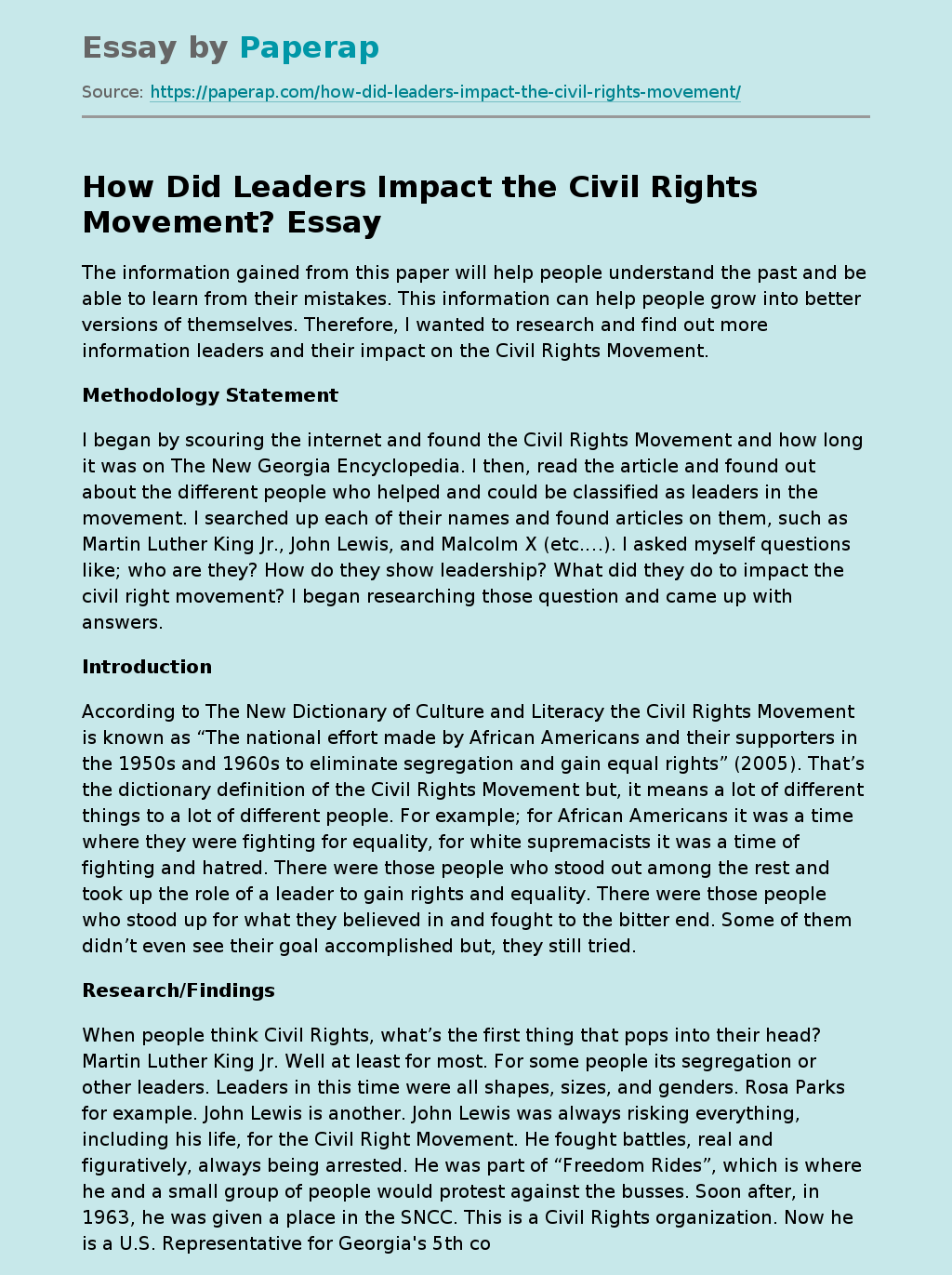How Did Leaders Impact the Civil Rights Movement?
The information gained from this paper will help people understand the past and be able to learn from their mistakes. This information can help people grow into better versions of themselves. Therefore, I wanted to research and find out more information leaders and their impact on the Civil Rights Movement.
Methodology Statement
I began by scouring the internet and found the Civil Rights Movement and how long it was on The New Georgia Encyclopedia. I then, read the article and found out about the different people who helped and could be classified as leaders in the movement.
I searched up each of their names and found articles on them, such as Martin Luther King Jr., John Lewis, and Malcolm X (etc.…). I asked myself questions like; who are they? How do they show leadership? What did they do to impact the civil right movement? I began researching those question and came up with answers.
Introduction
According to The New Dictionary of Culture and Literacy the Civil Rights Movement is known as “The national effort made by African Americans and their supporters in the 1950s and 1960s to eliminate segregation and gain equal rights” (2005).
That’s the dictionary definition of the Civil Rights Movement but, it means a lot of different things to a lot of different people. For example; for African Americans it was a time where they were fighting for equality, for white supremacists it was a time of fighting and hatred. There were those people who stood out among the rest and took up the role of a leader to gain rights and equality.
There were those people who stood up for what they believed in and fought to the bitter end. Some of them didn’t even see their goal accomplished but, they still tried.
Research/Findings
When people think Civil Rights, what’s the first thing that pops into their head? Martin Luther King Jr. Well at least for most. For some people its segregation or other leaders. Leaders in this time were all shapes, sizes, and genders. Rosa Parks for example. John Lewis is another. John Lewis was always risking everything, including his life, for the Civil Right Movement. He fought battles, real and figuratively, always being arrested. He was part of “Freedom Rides”, which is where he and a small group of people would protest against the busses. Soon after, in 1963, he was given a place in the SNCC. This is a Civil Rights organization. Now he is a U.S. Representative for Georgia’s 5th congressional district. (Georgia Humanities and the University of the Georgia Press, 2004-2018)
Elaine Brown is another great example. Elaine Brown was a chairwomen in the Black Panther Party. The Black Panther Party was made by Bobby Seale and was called the Black Panther Part only for self-defense. Elaine Brown was first introduced to the Black Panther Party when she started writing for the Black Congress Newspaper. They only then started to take notice of her when appeals for the Huey Newton Legal Defense Fund came in. It was long after in the end of April 1968 she went to her first official Black Panther meeting. She became the editor for The Black Panther. This was a huge achievement for her because after that she became the first elected female of the Panther central community. She helped lead other to do the same. (In the article, Brown, Elaine 1941-, 2017-2018).
Martin Luther King Jr. A man who helped everyone and anyone. He believed the way to get his and others rights was to have peaceful protests and no violence. He participated from anything to protests to boycotts. After Rosa Parks refused to give up her seat on the public Montgomery bus people started to plan a boycott. Martin being the leader he was joined along with boycott. Originally the boycott was supposed to be one day but, it ended up being 381 days. Before the boycott Martin had been asked to join the MIA. He agreed and ended up leading the whole thing. The boycott still continued even though lots of people were being arrested.(Georgia Humanities and The University of the Georgia Press, 2004, 2018).
How Did Leaders Impact the Civil Rights Movement?. (2021, Dec 14). Retrieved from https://paperap.com/how-did-leaders-impact-the-civil-rights-movement/

